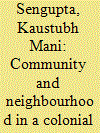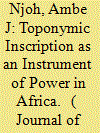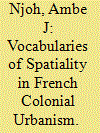|
|
|
Sort Order |
|
|
|
Items / Page
|
|
|
|
|
|
|
| Srl | Item |
| 1 |
ID:
157485


|
|
|
|
|
| Summary/Abstract |
This article on the history of neighbourhoods (para) of colonial Calcutta considers the processes through which this peculiar spatial unit emerged in the colonial city, where community identities were fostered as well as contested. Seen as a place, a secured, stable location which helped in forming the community in an alien atmosphere, the para was a liminal space, neither a purely affective unit nor an administrative category, and neither a purely public or private domain. Borrowing liberally from each register to generate a unique spatial experience, paras were at the same time deeply exclusionary and also starkly patriarchal zones. The article brings forth these various strands in the history of the neighbourhood to enrich the understanding of colonial urbanism, Bengali society and culture.
|
|
|
|
|
|
|
|
|
|
|
|
|
|
|
|
| 2 |
ID:
157195


|
|
|
|
|
| Summary/Abstract |
This study analyses toponymic inscription, the exercise of street/place naming, as a tool for articulating power in Anglophone and Francophone Africa. The focus is on Dakar, Senegal and Nairobi, Kenya, which were respectively indispensable for the colonial projects of France and Britain in Africa. Dakar was for France’s West African Federation what Nairobi was for Britain’s colonial East Africa. It is shown that toponymic inscription was used with equal zeal by French and British colonial authorities to express power in built space. Thus, both authorities used the occasion to christen streets and places as an opportunity to project Western power in Africa. With the demise of colonialism, indigenous authorities in Kenya inherited the Western vocabulary of spatiality but speedily moved to supplant Eurocentric with Afrocentric street/place-names. In contrast, post-colonial authorities in Senegal remain wedded to the colonial tradition of drawing most important street- and place-names from the Eurocentric cultural lexicon. Consequently, although the vocabulary of spatiality in Nairobi projects African nationalism and power, that of Dakar continues to express mainly Western power.
|
|
|
|
|
|
|
|
|
|
|
|
|
|
|
|
| 3 |
ID:
168250


|
|
|
|
|
| Summary/Abstract |
The study analyses toponymic practices in two colonial spaces on two continents. The colonial spaces, Dakar and Saigon, were capitals of the Federation of French West Africa and French Indochina, respectively. Toponymy is used as a tool to articulate socio-cultural and political power in both spaces; also, streets were christened after French military, politico-administrative and religious personalities. Two differences are noted. First, streets in colonial Saigon were named after French military heroes and clergymen, while streets in Dakar were named after French political luminaries. Second, post-colonial Saigon witnessed efforts to re-appropriate the city’s identity, but not so in Dakar.
|
|
|
|
|
|
|
|
|
|
|
|
|
|
|
|
|
|
|
|
|